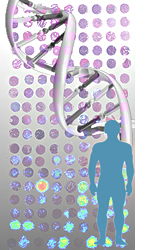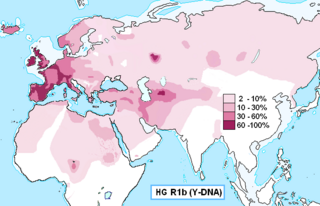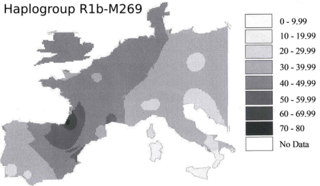In human genetics, the Atlantic modal haplotype (AMH) or haplotype 15 is a Y chromosome haplotype of Y-STR microsatellite variations, associated with the Haplogroup R1b. It was discovered prior to many of the SNPs now used to identify subclades of R1b and references to it can be found in some of the older literature. It corresponds most closely with subclade R1b1a2a1a(1) [L11].

Human genetics is the study of inheritance as it occurs in human beings. Human genetics encompasses a variety of overlapping fields including: classical genetics, cytogenetics, molecular genetics, biochemical genetics, genomics, population genetics, developmental genetics, clinical genetics, and genetic counseling.

The Y chromosome is one of two sex chromosomes (allosomes) in mammals, including humans, and many other animals. The other is the X chromosome. Y is the sex-determining chromosome in many species, since it is the presence or absence of Y that determines the male or female sex of offspring produced in sexual reproduction. In mammals, the Y chromosome contains the gene SRY, which triggers testis development. The DNA in the human Y chromosome is composed of about 59 million base pairs. The Y chromosome is passed only from father to son. With a 30% difference between humans and chimpanzees, the Y chromosome is one of the fastest-evolving parts of the human genome. To date, over 200 Y-linked genes have been identified. All Y-linked genes are expressed and hemizygous except in the cases of aneuploidy such as XYY syndrome or XXYY syndrome.

A haplotype is group of alleles in an organism that are inherited together from a single parent. However, there are other uses of this term. First, it is used to mean a collection of specific alleles in a cluster of tightly linked genes on a chromosome that are likely to be inherited together—that is, they are likely to be conserved as a sequence that survives the descent of many generations of reproduction. A second use is to mean a set of linked single-nucleotide polymorphism (SNP) alleles that tend to always occur together. It is thought that identifying these statistical associations and few alleles of a specific haplotype sequence can facilitate identifying all other such polymorphic sites that are nearby on the chromosome. Such information is critical for investigating the genetics of common diseases; which in fact have been investigated in humans by the International HapMap Project. Thirdly, many human genetic testing companies use the term in a third way: to refer to an individual collection of specific mutations within a given genetic segment;.
The AMH is the most frequently occurring haplotype amongst human males in Atlantic Europe. It is characterized by the following marker alleles:

Atlantic Europe is a geographical and anthropological term for the western portion of Europe which borders the Atlantic Ocean. The term may refer to the idea of Atlantic Europe as a cultural unit and/or as a biogeographical region.
An allele is a variant form of a given gene. Sometimes, the presence of different alleles of the same gene can result in different observable phenotypic traits, such as different pigmentation. A notable example of this trait of color variation is Gregor Mendel's discovery that the white and purple flower colors in pea plants were the result of "pure line" traits which could be used as a control for future experiments. However, most genetic variations result in little or no observable variation.
- DYS388 12
- DYS390 24
- DYS391 11
- DYS392 13
- DYS393 13
- DYS394 14 (also known as DYS19)
It reaches the highest frequencies in the Iberian Peninsula, in Great Britain and Ireland. In the Iberian Peninsula it reaches 70% in Portugal as a whole, more than 90% in NW Portugal and nearly 90% in Galicia (NW Spain), while the highest value is to be found among Spain and the Basques.

The Iberian Peninsula, also known as Iberia, is located in the southwest corner of Europe. The peninsula is principally divided between Spain and Portugal, comprising most of their territory. It also includes Andorra, small areas of France, and the British overseas territory of Gibraltar. With an area of approximately 596,740 square kilometres (230,400 sq mi)), it is the second largest European peninsula, after the Scandinavian Peninsula.

Great Britain is an island in the North Atlantic Ocean off the northwest coast of continental Europe. With an area of 209,331 km2 (80,823 sq mi), it is the largest of the British Isles, the largest European island, and the ninth-largest island in the world. In 2011, Great Britain had a population of about 61 million people, making it the world's third-most populous island after Java in Indonesia and Honshu in Japan. The island of Ireland is situated to the west of Great Britain, and together these islands, along with over 1,000 smaller surrounding islands, form the British Isles archipelago.

Ireland is an island in the North Atlantic. It is separated from Great Britain to its east by the North Channel, the Irish Sea, and St George's Channel. Ireland is the second-largest island of the British Isles, the third-largest in Europe, and the twentieth-largest on Earth.
One mutation in either direction, would be AMH 1.15+. The AMH 1.15 set of haplotypes is also referred to as the Atlantic modal cluster or AMC.
A Y-STR is a short tandem repeat (STR) on the Y-chromosome. Y-STRs are often used in forensics, paternity, and genealogical DNA testing.
Y-STRs are taken specifically from the male Y chromosome. These Y-STRs provide a weaker analysis than autosomal STRs because the Y chromosome is only found in males, which are only passed down by the father, making the Y chromosome in any paternal line practically identical. This causes a significantly smaller amount of distinction between Y-STR samples. Autosomal STRs provide a much stronger analytical power because of the random matching that occurs between pairs of chromosomes during the zygote making process.

Haplogroup G (M201) is a human Y-chromosome haplogroup. It is one of two branches of Haplogroup GHIJK, the other being Haplogroup HIJK.
Haplogroup J-M304, also known as J, is a human Y-chromosome DNA haplogroup. It is believed to have evolved in Western Asia. The clade spread from there during the Neolithic, primarily into North Africa, the Horn of Africa, Socotra, the Caucasus, Southern Europe, West Asia, Central Asia, South Asia, and Southeast Asia.
Haplogroup C is a major Y-chromosome haplogroup, defined by UEPs M130/RPS4Y711, P184, P255, and P260, which are all SNP mutations. It is one of two primary branches of Haplogroup CF alongside Haplogroup F. Haplogroup C is found in ancient populations on every continent except Africa and is the predominant Y-DNA haplogroup among males belonging to many peoples indigenous to East Asia, Central Asia, Siberia, North America and Oceania. The haplogroup is also found at moderate frequencies among certain indigenous populations of South Asia and Southeast Asia as well as low frequencies among some populations of Europe.

In genetic genealogy and human genetics, Y DNA haplogroup J-M267, also commonly known as haplogroup J1, is a subclade (branch) of Y-DNA haplogroup J-P209 along with its sibling clade Y DNA haplogroup J-M172.
A surname DNA project is a genetic genealogy project which uses genealogical DNA tests to trace male lineage.

Haplogroup R1b (R-M343), also known as Hg1 and Eu18, is a human Y-chromosome haplogroup.
In human genetics, Haplotype 35, also called ht35 or the Armenian Modal Haplotype, is a Y chromosome haplotype of Y-STR microsatellite variations, associated with the Haplogroup R1b. It is characterized by DYS393=12. The members of this haplotype are found in high numbers in Anatolia and Armenia, with smaller numbers throughout Central Asia, the Middle East, the Balkans, the Caucus Mountains, and in Jewish populations. They are also present in Britain in areas that were found to have a high concentration of Haplogroup J, suggesting they arrived together, perhaps through Roman soldiers.

In human genetics, Haplogroup G-M285, also known as Haplogroup G1, is a Y-chromosome haplogroup. Haplogroup G1 is a primary subclade of haplogroup G.
In human genetics, Haplogroup G-M406 is a Y-chromosome haplogroup. G-M406 is a branch of Haplogroup G Y-DNA (M201). More specifically in descending order, G-M406 is a subbranch also of G2 (P287), G2a (P15) and finally G2a2b (L30/S126) Haplogroup G-M406 seems most common in Turkey and Greece. Secondary concentrations of G-M406 are found in the northern and eastern Mediterranean, and it is found in very small numbers in more inland areas of Europe, the Middle East, and the southern Caucasus Mountains area.

In human genetics, Haplogroup R-M167 (R1b1a1a2a1a2a1b1a1) is a Y-chromosome haplogroup which is a subdivision of Haplogroup R-DF27 and the wider haplogroup R-M269 defined by the presence of the marker M167.
The ancestry of modern Iberians is consistent with the geographical situation of the Iberian Peninsula in the south-west corner of Europe. The large predominance of Y-Chromosome Haplogroup R1b, common throughout Western Europe, is the result of Central European invaders during the Bronze Age, making the Spanish and Portuguese population closely related to others from Western Europe. Similar to Sardinia and unlike the Balkans and Italy, Iberia was shielded from settlement from the Bosporus and Caucasus region by its western geographic location, and its low level of Western Asian admixture probably arrived during the Roman period. Later historical Eastern Mediterranean and Middle Eastern genetic contribution to the Iberia gene-pool was also significant, driven by Phoenicians, Greeks, Carthaginians, Jews and Levantine Arabs.
The genetic history of North Africa has been heavily influenced by geography. The Sahara desert to the south and the Mediterranean Sea to the North were important barriers to gene flow in prehistoric times. However, Africa is connected to Western Asia via the Isthmus of Suez, while at the Straits of Gibraltar North Africa and Europe are separated by only 15 km (9 mi).
Moroccan genetics encompasses the genetic history of the people of Morocco, and the genetic influence of this ancestry on world populations. It has been heavily influenced by geography.
Population genetics is a scientific discipline which contributes to the examination of the human evolutionary and historical migrations. Particularly useful information is provided by the research of two uniparental markers within our genome, the Y-chromosome (Y-DNA) and mitochondrial DNA (mtDNA). The studied data suggests that around 3/4 of the contemporary Croatian male individuals are the descendants of Old Europeans who came here before and after the Last Glacial Maximum (LGM), while the rest of the population from those who arrived in the last 10,000 years, mostly during the Neolithic period. The contemporary Croatian female individuals have genetic diversity which fits within a broader European maternal genetic landscape.
Haplogroup T-L206, also known as haplogroup T1, is a human Y-chromosome DNA haplogroup. The SNP that defines the T1 clade is L206. The haplogroup is one two primary branches of T (T-M184), the other subclade being T2 (T-PH110).

As with all modern European nations, a large degree of 'biological continuity' exists between the Bosniaks and their ancient predecessors with Bosniak Y chromosomal lineages testifying to predominantly Paleolithic European ancestry. A majority (>67%) of Bosniaks belong to one of the three major European Y-DNA haplogroups: I (50.5%), R1a (14%) and R1b (3.5%), while a minority belongs to less frequently occurring haplogroups E (11.5%), J2 (5%), G (1.5%) and F (1.5%) along with other more rare lineages.

In human genetics, Haplogroup R-DF27 (R1b1a2a1a2a) is a Y-chromosome haplogroup which is a subdivision of haplogroup R-M269 defined by the presence of the marker DF27. Along with R-U152 and R-L21, the lineage is to a significant extent associated with Proto-Celtic, Celtic and later Celtiberian movements.
Haplogroup E-M2 is a human Y-chromosome DNA haplogroup. It is primarily distributed in Africa. E-M2 is the predominant subclade in Western Africa, Central Africa, Southern Africa and the African Great Lakes, and occurs at moderate frequencies in North Africa and Middle East. E-M2 has several subclades, but many of these subhaplogroups are included in either E-L485 or E-U175. E-M2 is especially common in native Africans speaking Niger-Congo languages and was spread to Southern and Eastern Africa through the Bantu expansion.













